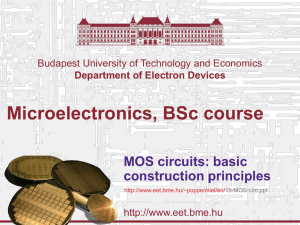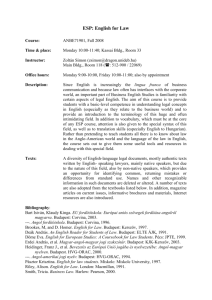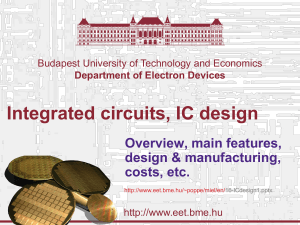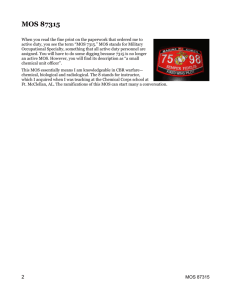D latch
advertisement
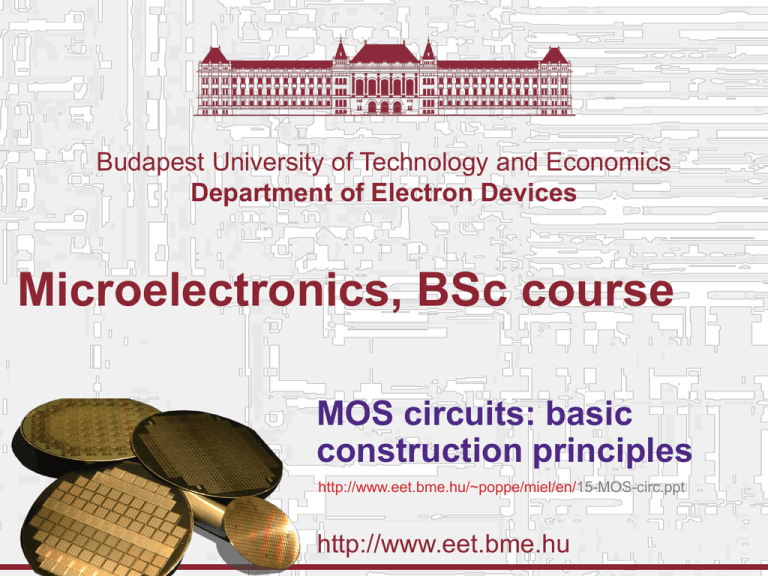
Budapest University of Technology and Economics Department of Electron Devices Microelectronics, BSc course MOS circuits: basic construction principles http://www.eet.bme.hu/~poppe/miel/en/15-MOS-circ.ppt http://www.eet.bme.hu Budapest University of Technology and Economics Department of Electron Devices The abstraction level of our study: SYSTEM MODULE + GATE CIRCUIT Vin Vout DEVICE G S n+ 13-11-2008 MOS circuits © András Poppe, BME-EET 2008 D n+ 2 Budapest University of Technology and Economics Department of Electron Devices Recall: CMOS gates ► ► ► nMOS network: pulls down the output to GND: Pull-Down Network (PDN) pMOS network: pulls up the output to VDD: Pull-Up Network (PUN) PUN and PDN are dual networks (duality both in terms of VDD graph topology and elements) VDD In1 In2 VDD B PUN InN Y F(In1,In2,…InN) A Y A B 13-11-2008 MOS circuits © András Poppe, BME-EET 2008 In1 In2 InN PDN 3 Budapest University of Technology and Economics Department of Electron Devices Complex gate – still "simple": A C B D X D X = !((A+B)•(C+D)) C D A B 13-11-2008 C VDD X B A B C D MOS circuits © András Poppe, BME-EET 2008 PUN A GND PDN 4 Budapest University of Technology and Economics Department of Electron Devices Creating dual networks A C A E B 13-11-2008 C E D MOS circuits © András Poppe, BME-EET 2008 B D 5 Budapest University of Technology and Economics Department of Electron Devices Static CMOS full adder !Sum = Cout & (!A | !B | !Cin) | (!A & !B & !Cin) !Cout = !Cin & (!A | !B) | (!A & !B) B A B B A Cin A B Cin Cin !Cout !Sum A B A B A Cin A B Cin A B Cout = Cin & (A | B) | (A & B) 13-11-2008 MOS circuits © András Poppe, BME-EET 2008 Sum = !Cout & (A | B | Cin) | (A & B & Cin) 6 Budapest University of Technology and Economics Department of Electron Devices Application of transmission gates ► The full adder realized by conventional static CMOS technique is too complex, requires too many transistors. ► Simplification: application of transmission gates ► Logic function is created not only by switching in the VDD-GND conduction path switch inserted anywhere in a signal path analog switch in a digital circuit 13-11-2008 MOS circuits © András Poppe, BME-EET 2008 7 Budapest University of Technology and Economics Department of Electron Devices Logic with transmission gates ► In CMOS: n/p transistors with inverted control (gate) voltages Transmission gate with inverted control Transmission gate with builtin inverter ► less transistors are needed ► reversible signal path ► no static power consumption ► limitation: insertion resistance – do not use more than 4 transmission gates in a signal path 13-11-2008 MOS circuits © András Poppe, BME-EET 2008 8 Budapest University of Technology and Economics Department of Electron Devices Examples with transmission gates ► Typical: XOR, mux/demux XOR gate: B Y = A XOR B A 4 input MUX: NS0 S0 NS1 D0 NS0 S1 NS1 D3 S0 S1 D1 S1 D2 D1 NS0 S0 S1 NS1 D2 NS0 NS1 Y D0 Y NS1 D3 S0 13-11-2008 S1 MOS circuits © András Poppe, BME-EET 2008 9 Budapest University of Technology and Economics Department of Electron Devices Layout of a TG MUX S S S S F S VDD In2 S F In1 S F = !(In1 S + In2 S) GND In1 13-11-2008 MOS circuits © András Poppe, BME-EET 2008 In2 10 Budapest University of Technology and Economics Department of Electron Devices Full adders with TG-s Cin B A Sum 16 tr. Cout 13-11-2008 MOS circuits © András Poppe, BME-EET 2008 11 Budapest University of Technology and Economics Department of Electron Devices Static CMOS full adder !Sum = Cout & (!A | !B | !Cin) | (!A & !B & !Cin) !Cout = !Cin & (!A | !B) | (!A & !B) B A B B A Cin A B Cin Cin !Cout !Sum A B A B A Cin A B Cin A 23 tr. B Cout = Cin & (A | B) | (A & B) 13-11-2008 MOS circuits © András Poppe, BME-EET 2008 Sum = !Cout & (A | B | Cin) | (A & B & Cin) 12 Budapest University of Technology and Economics Department of Electron Devices Dynamic MOS logic ► Principle: 2 phase operation a switching pMOS transistor charges a capacitor to the VDD voltage: pre-charge phase in the next phase the capacitor is disconnected from VDD and it is discharged or is left intact through an nMOS logic circuit (according to the logic function realized by this PDN): this is the evaluation phase Φ pre-charge Mp Out In1 In2 In3 Φ 13-11-2008 Φ CL PDN evaluation Me t MOS circuits © András Poppe, BME-EET 2008 13 Budapest University of Technology and Economics Department of Electron Devices Dynamic gates Φ Φ Mp Mp Out In1 In2 In3 Φ CL PDN Out A C B Me Φ Me Two phase operation: Precharge (Φ = 0) Evaluate (Φ = 1) 13-11-2008 MOS circuits © András Poppe, BME-EET 2008 14 Budapest University of Technology and Economics Department of Electron Devices Dynamic gates Φ Φ Mp off Mp on Out In1 In2 In3 Φ CL A PDN C B Me Φ Two phase operation: Precharge (Φ = 0) Evaluate (Φ = 1) 13-11-2008 1 Out !((A&B)|C) off Me on If the output of a dynamic gate is discharged, it can not be discharged again until charged up in a pre-charge phase MOS circuits © András Poppe, BME-EET 2008 15 Budapest University of Technology and Economics Department of Electron Devices Major properties of dynamic gates ► The logic function is realized by the PDN instead of 2N transistors only N+2 transistors are needed smaller area than in in case of static CMOS ► Geometrical ratios do not play important role in the operation ► There is only dynamic power consumption ► A pre-charge clock signal is needed 13-11-2008 MOS circuits © András Poppe, BME-EET 2008 16 Budapest University of Technology and Economics Department of Electron Devices Dynamic operation CLK Out 2.5 Evaluate In1 In2 1.5 In3 In & CLK 0.5 In4 CLK Precharge -0.5 0 13-11-2008 Out MOS circuits © András Poppe, BME-EET 2008 0.5 Time, ns 1 17 Budapest University of Technology and Economics Department of Electron Devices Storage circuits: dynamic D ff ► Dynamic latch & ff "Analog SH" circuits in a digital environment Storage capacitor: input capacitance of the inverter D /Q EN CIN Two latches in series, controlled by non-overlapping signals: master-slave FF CK CK1 D 2 Q CK2 13-11-2008 CK1 MOS circuits © András Poppe, BME-EET 2008 18 Budapest University of Technology and Economics Department of Electron Devices Storage circuits: dynamic D ff ► Simplified version: No need for a second, non-overlapping CLK transmission gate with inverted control CLK D /CLK Q CLK 13-11-2008 MOS circuits © András Poppe, BME-EET 2008 19 Budapest University of Technology and Economics Department of Electron Devices Static latches and ff-s ► Can be constructed from logic gates with feedback loops /S /R Q D Q /Q /Q EN RS-latch Extended: D-latch D-latch 5 cells, 18 transistors 13-11-2008 MOS circuits © András Poppe, BME-EET 2008 20 Budapest University of Technology and Economics Department of Electron Devices D latch ► with OR-AND-INVERT gate: D Q Q /Q /Q /EN D /EN /D The dynamic version took less space/transistors 13-11-2008 MOS circuits © András Poppe, BME-EET 2008 21 Budapest University of Technology and Economics Department of Electron Devices D flip-flop ► two D latches in series with inverted clock signal D Q QN Q D /Q CLK 13-11-2008 MOS circuits © András Poppe, BME-EET 2008 22 Budapest University of Technology and Economics Department of Electron Devices Memories – hierarchy On-Chip Components Control eDRAM Instr Data Cache Cache .1’s 1’s 10’s 100’s Size (bytes): 100’s K’s 10K’s M’s Cost: 13-11-2008 ITLB DTLB Speed (ns): Datapath RegFile Second Level Cache (SRAM) highest MOS circuits © András Poppe, BME-EET 2008 Main Memory (DRAM) Secondary Memory (Disk) 1,000’s T’s lowest 23 Budapest University of Technology and Economics Department of Electron Devices Semiconductor memories RWM NVRWM ROM EPROM Maskprogrammed Random Access SRAM (cache, register file) Non-Random Access FIFO/LIFO E2PROM DRAM Shift Register FLASH CAM Electricallyprogrammed (PROM) See the structures later 13-11-2008 MOS circuits © András Poppe, BME-EET 2008 24 Budapest University of Technology and Economics Department of Electron Devices Development of DRAMs 1000000 256 000 100000 Kbit capacity 64 000 16 000 10000 4 000 1000 1 000 256 100 64 See the structures later 10 1980 1982 1984 1986 1988 1990 1992 1994 1996 1998 2000 Year of introduction 13-11-2008 MOS circuits © András Poppe, BME-EET 2008 25
